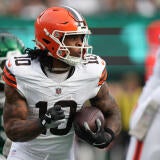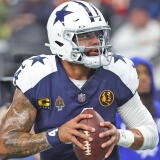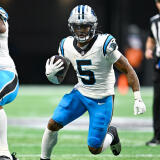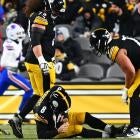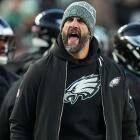History says Chiefs RB Jamaal Charles should be productive following ACL surgery
Time of recovery and age have historically factored in how well running backs return from ACL surgery. The success of the 2012 Chiefs rests somewhat on the ACL-repaired knee of Jamaal Charles, and the Chiefs are wisely bringing along their star running back cautiously.
The success of the 2012 Chiefs rests somewhat on the ACL-repaired knee of Jamaal Charles, and the Chiefs are wisely bringing along their star running back cautiously.
Charles did not practice in pads on Tuesday and will sit out the occasional practice during training camp.
Kansas City's coaches have plenty of examples to study when it comes to how to bring Charles back into the mold. Running backs, more than any other position, are prone to ACL tears and last season alone the injury claimed Charles, Adrian Peterson, Rashard Mendenhall, Knowshon Morenoand Tim Hightower.
The timing of Charles' ACL tear (Week 2) could not have been worse for the Chiefs in 2011. But if it was going to happen at some point, the timing could be beneficial for the 2012 Chiefs.
"My legs feel fresh since I've been out of football for a year," Charles said earlier this week. "I feel real good just to be on the field again. I'm blessed."
The running back most comparable to Charles who has returned from a torn ACL is former NFL star Edgerrin James. James, like Charles, had good speed and thrived in the open field early on in his career. James was 24 when he returned from his ACL surgery. Charles is 25.
When James returned in 2002, the Colts rode him hard the first three weeks, handing him the ball 81 times in three games. It was the only season in James' first seven years in the league in which he did not average better than 4.0 yards per carry.
The Chiefs signed Peyton Hillis to avoid a similar mistake with Charles. Hillis, like Thomas Jones in 2010, will likely get close to 50 percent of the carries. That season Charles had less carries than Jones but still managed to rush for 1,467 yards.
The other advantage Charles has is the timing of his injury. James' injury occurred six weeks into the 2001 season. Jamal Lewis, the top success story when it comes to returning from an ACL tear, had the benefit of an entire year to recover.
Lewis' injury occurred in the summer of 2001 and he missed the entire 2001 season. His return in 2002 produced nearly identical numbers to his 2000 season (see chart below).
The common perception is that it takes 8-12 months to return to the field following ACL surgery, but it takes a full healthy season to return to your former self.
That would make sense for Lewis, who had a breakout season in his second year back. However, it could be argued that Lewis' age had more to do with his success than the fact that he was two years removed from surgery. Lewis was 24 in 2002 -- right at the prime age for a running back.
As the list below illustrates, it's difficult to suggest that Charles will be better in 2013 than he is in 2012. Age and the timing of the injury seem to be the most important factors in determining immediate success, and Charles is in the perfect range for both.
The following is a list of running backs who tore their ACL. The first season listed is the year before the injury occurred; the next two seasons are the first two years back. (Note: Duece McAllister retired following his first season back.)
| Jamal Anderson | ||||||
| Terrell Davis | ||||||
| Edgerrin James | ||||||
| Jamal Lewis | ||||||
| Duece McAllister | ||||||
| Ronnie Brown | ||||||
| Jamal Charles | ||||||
Follow Chiefs reporter C.J. Moore on Twitter @CBSSportsNFLKC and @cjmoore4.

